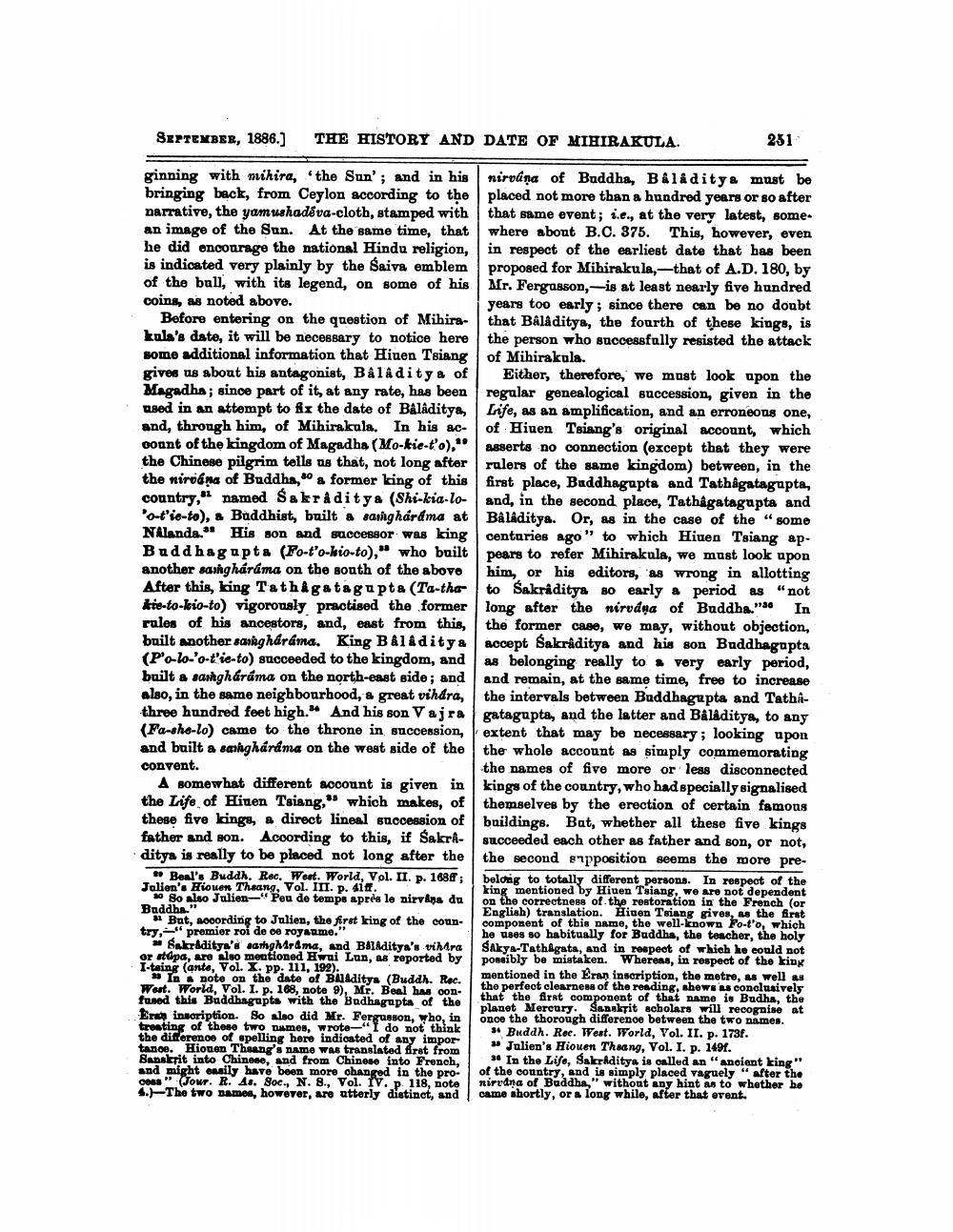________________
SEPTEMBER, 1886.] THE HISTORY AND DATE OF MIHIRAKULA.
ginning with mihira, the Sun'; and in his bringing back, from Ceylon according to the narrative, the yamushadéva-cloth, stamped with an image of the Sun. At the same time, that he did encourage the national Hindu religion, is indicated very plainly by the Saiva emblem of the bull, with its legend, on some of his coins, as noted above.
Before entering on the question of Mihirakula's date, it will be necessary to notice here some additional information that Hiuen Tsiang gives us about his antagonist, Bâlâditya of Magadha; since part of it, at any rate, has been used in an attempt to fix the date of Bâlâditya, and, through him, of Mihirakula. In his account of the kingdom of Magadha (Mo-kie-t'o)," the Chinese pilgrim tells us that, not long after the nirvana of Buddha, a former king of this country, named Sakråditya (Shi-kia-lo'o-t'ie-to), a Buddhist, built a samgháráma at Nalanda. His son and successor was king Buddhagupta (Fo-t'o-kio-to)," who built another saingháráma on the south of the above After this, king Tathagatagupta (Ta-tha kie-to-kio-to) vigorously practised the former rules of his ancestors, and, east from this, built another sanghåráma. King Bâlâdity a (P'o-lo-'o-t'ie-to) succeeded to the kingdom, and built a samgháráma on the north-east side; and also, in the same neighbourhood, a great vihdra, three hundred feet high." And his son Vajra (Fa-she-lo) came to the throne in succession, and built a sangháráma on the west side of the
convent.
A somewhat different account is given in the Life of Hiuen Tsiang," which makes, of these five kings, a direct lineal succession of father and son. According to this, if Sakrâditya is really to be placed not long after the
Beal's Buddh. Rec. West. World, Vol. II. p. 168ff; Jalien's Hiouen Theang, Vol. III. p. 41ff.
30 So also Julien-"Peu de temps après le nirvana du
Buddha."
But, according to Julien, the first king of the country," premier roi de ce royaume."
Sakråditya's samgharama, and BalAditya's vihara or stúpa, are also mentioned Hwai Lun, as reported by I-taing (ante, Vol. X. pp. 111, 192).
In a note on the date of BA1Aditya (Buddh. Rec. West. World, Vol. I. p. 168, note 9), Mr. Beal has confused this Buddhagupta with the Budhagupta of the Era inscription. So also did Mr. Fergusson, who, in treating of these two names, wrote-"I do not think the difference of spelling here indicated of any impor tance. Hionen Thaang's name was translated first from Sanskrit into Chinese, and from Chinese into French, and might easily have been more changed in the process" (Jour. R. As. Soc., N. 8., Vol. IV. p. 118, note 4.)-The two names, however, are utterly distinct, and
2512
nirvana of Buddha, Baladitya must be placed not more than a hundred years or so after that same event; ie., at the very latest, some. where about B.C. 375. This, however, even in respect of the earliest date that has been proposed for Mihirakula,-that of A.D. 180, by Mr. Fergusson,-is at least nearly five hundred years too early; since there can be no doubt that Bâlâditya, the fourth of these kings, is the person who successfully resisted the attack of Mihirakula.
Either, therefore, we must look upon the regular genealogical succession, given in the Life, as an amplification, and an erroneous one, of Hiuen Tsiang's original account, which asserts no connection (except that they were rulers of the same kingdom) between, in the first place, Buddhagupta and Tathagatagupta, and, in the second place, Tathagatagupta and Bâlâditya. Or, as in the case of the "some centuries ago" to which Hiuen Tsiang appears to refer Mihirakula, we must look upon him, or his editors, as wrong in allotting to Sakråditya so early a period as "not long after the nirvana of Buddha.""" In the former case, we may, without objection, accept Sakrâditya and his son Buddhagupta as belonging really to a very early period, and remain, at the same time, free to increase the intervals between Buddhagupta and Tathagatagupta, and the latter and Bâlâditya, to any extent that may be necessary; looking upon the whole account as simply commemorating the names of five more or less disconnected kings of the country, who had specially signalised themselves by the erection of certain famous buildings. But, whether all these five kings succeeded each other as father and son, or not, the second supposition seems the more prebelong to totally different persons. In respect of the king mentioned by Hiuen Tsiang, we are not dependent on the correctness of the restoration in the French (or English) translation. Hiuen Tsiang gives, as the first component of this name, the well-known Fo-t'o, which he uses so habitually for Buddha, the teacher, the holy Sakya-Tathagata, and in respect of which he could not possibly be mistaken. Whereas, in respect of the king mentioned in the Eran inscription, the metre, as well as the perfect clearness of the reading, shews as conclusively that the first component of that name is Budha, the planet Mercury. Sanskrit scholars will recognise at once the thorough difference between the two names. 3 Buddh. Rec. West. World, Vol. II. 173f. Julien's Hiouen Thaang, Vol. I. p. 149f.
p.
3 In the Life, Sakraditya is called an "ancient king" of the country, and is simply placed vaguely "after the nirvana of Buddha," without any hint as to whether he came shortly, or a long while, after that event.




